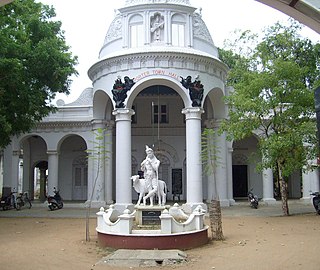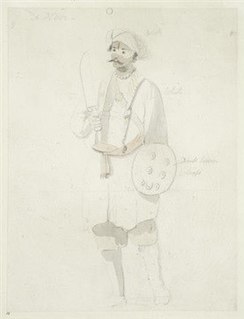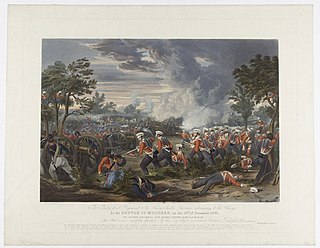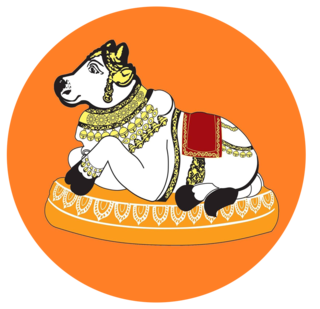
Kumbakonam, is a city and a special grade municipality in the Thanjavur district. It is located 40 km (25 mi) from Thanjavur and 273 km (170 mi) from Chennai. Kumbakonam is known as a "temple city" due to the prevalence of a number of temples here and is noted for its Mahamaham festival which attracts people from all over the country.It is the third largest city in central Tamil Nadu and second largest city in Cauvery delta region.It is one of the economic hub of Central Tamil nadu.
Richard Gough was a prominent and influential English antiquarian. He served as director of the Society of Antiquaries of London from 1771 to 1791; published a major work on English church monuments; and translated and edited a new edition of William Camden's Britannia.

Field Marshal Hugh Gough, 1st Viscount Gough, was a British Army officer. After serving as a junior officer at the seizure of the Cape of Good Hope during the French Revolutionary Wars, Gough commanded the 2nd Battalion of the 87th Regiment of Foot during the Peninsular War. After serving as commander-in-chief of the British forces in China during the First Opium War, he became Commander-in-Chief, India and led the British forces in action against the Mahrattas defeating them decisively at the conclusion of the Gwalior Campaign and then commanded the troops that defeated the Sikhs during both the First Anglo-Sikh War and the Second Anglo-Sikh War for which he became known as the 'hammer of the Sikhs'.

The First Anglo-Sikh War was fought between the Sikh Empire and the East India Company between 1845 and 1846. It resulted in partial subjugation of the Sikh kingdom and cession of Jammu and Kashmir as a separate princely state under British suzerainty.

The Second Anglo-Sikh War was a military conflict between the Sikh Empire and the British East India Company that took place in 1848 and 1849. It resulted in the fall of the Sikh Empire, and the annexation of the Punjab and what subsequently became the North-West Frontier Province, by the East India Company.

The Nair, also known as Nayar, are a group of Indian Hindu castes, described by anthropologist Kathleen Gough as "not a unitary group but a named category of castes". The Nair include several castes and many subdivisions, not all of whom historically bore the name 'Nair'. These people lived, and continue to live, in the area which is now the Indian state of Kerala. Their internal caste behaviours and systems are markedly different between the people in the northern and southern sections of the area, although there is not very much reliable information on those inhabiting the north.

Gough Island, also known historically as Gonçalo Álvares after the Portuguese explorer, is a rugged volcanic island in the South Atlantic Ocean. It is a dependency of Tristan da Cunha and part of the British overseas territory of Saint Helena, Ascension and Tristan da Cunha. It is about 400 km (250 mi) south-east of the Tristan da Cunha archipelago, 2,400 km (1,500 mi) north-east from South Georgia Island, 2,700 km (1,700 mi) west from Cape Town, and over 3,200 km (2,000 mi) from the nearest point of South America.
Vidyaranya is variously known as a kingmaker, patron saint and high priest to Harihara I and Bukka Raya I, the founders of the Vijayanagara Empire. He was the 12th Jagadguru of the Śringeri Śarada Pītham from 1380-1386.
The Battle of Chillianwala was fought in January 1849 during the Second Anglo-Sikh War in the Chillianwala region of Punjab, now part of modern-day Pakistan. The battle was one of the bloodiest fought by the British East India Company. Both armies held their positions at the end of the battle and both sides claimed victory. The battle was a strategic check to immediate British ambitions in India and a shock to British military prestige.

The Battle of Mudki was fought on 18 December 1845, between the forces of the East India Company and part of the Sikh Khalsa Army, the army of the Sikh Empire of the Punjab. The British army won an untidy encounter battle, suffering heavy casualties.

The Battle of Gujrat was a decisive battle in the Second Anglo-Sikh War, fought on 21 February 1849, between the forces of the East India Company, and a Sikh army in rebellion against the Company's control of the Sikh Empire, represented by the child Maharaja Duleep Singh who was in British custody in Lahore. The Sikh army was defeated by the British regular and Bengal Army forces of the British East India Company. After it capitulated a few days later, the Punjab was annexed to the East India Company's territories and Duleep Singh was deposed.
Vellalar is a Tamil caste found mainly in the Indian states of Tamil Nadu, Kerala and in northeastern parts of Sri Lanka. They are traditionally involved in agriculture also serving as landlords.

Hoath is a semi-rural village and civil parish in the City of Canterbury local government district. The hamlets of Knaves Ash, Maypole, Ford, Old Tree, Shelvingford and Stoney Acre are included in the parish.
The Vanniyar, also spelled Vanniya, who were once known as the Palli, are a community or jāti found in Southern India.

Naduvazhi refers to landlords, chieftains and descendants of royal households in the region now known as Kerala, India.
The Ezhavas are a community with origins in the region of India presently known as Kerala. They are also known as Ilhava, Irava, Izhava and Erava in the south of the region; as Chovas, Chokons and Chogons in Central Travancore; and as Thiyyas, Tiyyas and Theeyas in the Malabar region. Some are also known as Thandan, which has caused administrative difficulties due to the presence of a distinct caste of Thandan in the same region. The Malabar Thiyya group have claimed a higher ranking in the Hindu caste system than do the others, although from the perspective of the colonial and subsequent administrations they were treated as being of similar rank.

Pashupata Shaivism is the oldest of the major Shaivite Hindu schools. There is a debate about pioneership of this school and Goan school of Nakulish darshan believes that Nakulish was pioneer and Lakulish and Patanjalinath were his disciples while Gujrat school believes that Nakulish and Lakulish are one. Sarwdarshansangrah written by Madhavachary mentiones it as "Nakulish Darshan" not as "Lakulish Darshan". Both sub schools are still active in their own areas. The philosophy of the Pashupata sect was systematized by Lakulīśa also called Nakulīśa) in the 2nd century A.D. The main texts of the school are Pāśupatasūtra with Kauṇḍinya's Pañcārthabhāṣya, and Gaṇakārikā with Bhāsarvajña's Ratnaṭīkā. Both texts were discovered only in the twentieth century. Prior to that, the major source of information on this sect was a chapter devoted to it in Vidyāraṇya's Sarvadarśanasaṅgraha.
Kaniyar is a caste from the Indian state of Kerala. There are regional variations in the name used to define them. The Kerala Public Service Commission considers Kaniyar Panicker to be one group in their list of designated Other Backward Classes, and Kalari Panicker to be another.
Westley Gough is a New Zealand professional racing cyclist. In 2011 he won the New Zealand National Road Championships ITT.















